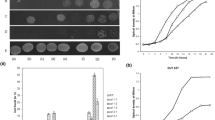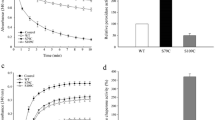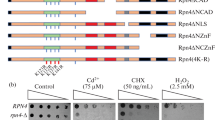Abstract
Cyclophilins are conserved cis-trans peptidyl-prolyl isomerase that are implicated in protein folding and function as molecular chaperones. We found the expression of cyclophilin A, Cpr1, changes in response to exposure to yeast Saccharomyces cerevisiae to abiotic stress conditions. The effect of Cpr1 overexpression in stress responses was therefore examined. The CPR1 gene was cloned to the yeast expression vector pVTU260 under regulation of an endogenous alcohol dehydrogenase (ADH) promoter. The overexpression of Cpr1 drastically increased cell viability of yeast in the presence of stress inducers, such as cadmium, cobalt, copper, hydrogen peroxide, tert-butyl hydroperoxide (t-BOOH), and sodium dodecyl sulfate (SDS). The Cpr1 expression also enhanced the cell rescue program resulting in a variety of antioxidanr enzymes including thioredoxin system (particularly, thioredoxin peroxidase), metabolic enzymes (glucose-6-phosphate dehydrogenase and glyceraldehyde-3-phosphate dehydrogenase), and molecular chaperones (Hsp104, Hsp90, Hsp60 and Hsp42). Thus, our study illustrates the importance of Cpr1 as a molecular chaperone that improves cellular stress responses through collaborative relationships with other proteins when yeast cells are exposed to adverse conditions, and it also premises the improvement of yeast strains.
Similar content being viewed by others
References
Adamis, P.D., Gomes, D.S., Pereira, M.D., Freire de Mesquita, J., Pinto, M.L., Panek, A.D., and Eleutherio, E.C. (2004). The effect of superoxide dismutase deficiency on cadmium stress. J. Biochem. Mol. Toxicol. 18, 12–17.
Arevalo-Rodriguez, M., and Heitman, J. (2005). Cyclophilin A is localized to the nucleus and controls meiosis in Saccharomyces cerevisiae. Eukaryot. Cell 4, 17–29.
Arevalo-Rodriguez, M., Cardenas, M.E., Wu, X., Hanes, S.D., and Heitman, J. (2000). Cyclophilin A and Ess1 interact with and regulate silencing by the Sin3-Rpd3 histone deacetylase. EMBO J. 19, 3739–3749.
Arevalo-Rodriguez, M., Wu, X., Hanes, S.D., and Heitman, J. (2004). Prolyl isomerases in yeast. Front. Biosci. 9, 2420–2446.
Barik, S. (2006). Immunophilins: for the love of proteins. Cell. Mol. Life Sci. 63, 2889–2900.
Berger, R., Schauwecker, F., and Keller, U. (1999). Transcriptional analysis of the cyclophilin A gene (cypA) of Streptomyces chrysomallus. FEMS Microbiol. Lett. 178, 39–45.
Bernier-Villamor, L., Navarro, E., Sevilla, F., and Lazaro, J.J. (2004). Cloning and characterization of a 2-Cys peroxiredoxin from Pisum sativum. J. Exp. Bot. 55, 2191–2199.
Brown, C.R., Cui, D.Y., Hung, G.G., and Chiang, H.L. (2001). Cyclophilin A mediates Vid22p function in the import of fructose-1,6-bisphosphatase into Vid vesicles. J. Biol. Chem. 276, 48017–48026.
Cabiscol, E., Piulats, E., Echave, P., Herrero, E., and Ros, J. (2000). Oxidative stress promotes specific protein damage in Saccharomyces cerevisiae. J. Biol. Chem. 275, 27393–27398.
Cabiscol, E., Belli, G., Tamarit, J., Echave, P., Herrero, E., and Ros, J. (2002). Mitochondrial Hsp60, resistance to oxidative stress, and the labile iron pool are closely connected in Saccharomyces cerevisiae. J. Biol. Chem. 277, 44531–44538.
Chen, X., Guo, P., Xie, Z., and Shen, P. (2001). A convenient and rapid method for genetic transformation of E. coli with plasmids. Antonie Van Leeuwenhoek 80, 297–300.
Chen, A.P., Wang, G.L., Qu, Z.L., Lu, C.X., Liu, N., Wang, F., and Xia, G.X. (2007). Ectopic expression of ThCYP1, a stressresponsive cyclophilin gene from Thellungiella halophila, confers salt tolerance in fission yeast and tobacco cells. Plant Cell Rep. 26, 237–245.
Coaker, G., Falick, A., and Staskawicz, B. (2005). Activation of a phytopathogenic bacterial effector protein by a eukaryotic cyclophilin. Science 308, 548–550.
Costa, V.M., Amorim, M.A., Quintanilha, A., and Moradas-Ferreira, P. (2002). Hydrogen peroxide-induced carbonylation of key metabolic enzymes in Saccharomyces cerevisiae: the involvement of the oxidative stress response regulators Yap1 and Skn7. Free Radic. Biol. Med. 33, 1507–1515.
Costa, V., Quintanilha, A., and Moradas-Ferreira, P. (2007). Protein oxidation, repair mechanisms and proteolysis in Saccharomyces cerevisiae. IUBMB Life 59, 293–298.
Dolinski, K., Muir, S., Cardenas, M., and Heitman, J. (1997). All cyclophilins and FK506 binding proteins are, individually and collectively, dispensable for viability in Saccharomyces cerevisiae. Proc. Natl. Acad. Sci. USA 94, 13093–13098.
Dominguez-Solis, J.R., He, Z., Lima, A., Ting, J., Buchanan, B.B., and Luan, S. (2008). A cyclophilin links redox and light signals to cysteine biosynthesis and stress responses in chloroplasts. Proc. Natl. Acad. Sci. USA 105, 16386–16391.
Doyle, V., Virji, S., and Crompton, M. (1999). Evidence that cyclophilin-A protects cells against oxidative stress. Biochem. J. 341, 127–132.
Drahota, Z., Krivakova, P., Cervinkova, Z., Kmonickova, E., Lotkova, H., Kucera, O., and Houstek, J. (2005). Tert-butyl hydroperoxide selectively inhibits mitochondrial respiratory-chain enzymes in isolated rat hepatocytes. Physiol. Res. 54, 67–72.
Fratelli, M., Demol, H., Puype, M., Casagrande, S., Eberini, I., Salmona, M., Bonetto, V., Mengozzi, M., Duffieux, F., Miclet, E., et al. (2002). Identification by redox proteomics of glutathionylated proteins in oxidatively stressed human T lymphocytes. Proc. Natl. Acad. Sci. USA 99, 3505–3510.
Galat, A. (2004). Function-dependent clustering of orthologues and paralogues of cyclophilins. Proteins 56, 808–820.
Gietz, R.D., and Schiestl, R.H. (2007). High-efficiency yeast transformation using the LiAc/SS carrier DNA/PEG method. Nat. Protoc. 2, 31–34.
Howlett, N.G., and Avery, S.V. (1997). Induction of lipid peroxidation during heavy metal stress in Saccharomyces cerevisiae and influence of plasma membrane fatty acid unsaturation. Appl. Environ. Microbiol. 63, 2971–2976.
Izawa, S., Ikeda, K., Ohdate, T., and Inoue, Y. (2007). Msn2p/Msn4p-activation is essential for the recovery from freezing stress in yeast. Biochem. Biophys. Res. Commun. 352, 750–755.
Jaschke, A., Mi, H., and Tropschug, M. (1998). Human T cell cyclophilin18 binds to thiol-specific antioxidant protein Aop1 and stimulates its activity. J. Mol. Biol. 277, 763–769.
Kim, I.S., Yun, H.S., Park, I.S., Sohn, H.Y., Iwahashi, H., and Jin, I.N. (2006). A knockout strain of CPR1 induced during fermentation of Saccharomyces cerevisiae KNU5377 is susceptible to various types of stress. J. Biosci. Bioeng. 102, 288–296.
Kim, J., Choi, T.G., Ding, Y., Kim, Y., Ha, K.S., Lee, K.H., Kang, I., Ha, J., Kaufman, R.J., Lee, J., et al. (2008). Overexpressed cyclophilin B suppresses apoptosis associated with ROS and Ca2+ homeostasis after ER stress. J. Cell. Sci. 121, 3636–3648.
Laemmli, U.K. (1970). Cleavage of structural proteins during the assembly of the head of bacteriophage T4. Nature 227, 680–685.
Laxa, M., Konig, J., Dietz, K.J., and Kandlbinder, A. (2007). Role of the cysteine residues in Arabidopsis thaliana cyclophilin CYP20-3 in peptidyl-prolyl cis-trans isomerase and redox-related functions. Biochem. J. 401, 287–297.
Lee, J.P., Palfrey, H.C., Bindokas, V.P., Ghadge, G.D., Ma, L., Miller, R.J., and Roos, R.P. (1999). The role of immunophilins in mutant superoxide dismutase-1linked familial amyotrophic lateral sclerosis. Proc. Natl. Acad. Sci. USA 96, 3251–3256.
Lee, S.P., Hwang, Y.S., Kim, Y.J., Kwon, K.S., Kim, H.J., Kim, K., and Chae, H.Z. (2001). Cyclophilin a binds to peroxiredoxins and activates its peroxidase activity. J. Biol. Chem. 276, 29826–29832.
Lewinska, A., and Bartosz, G. (2007). Protection of yeast lacking the Ure2 protein against the toxicity of heavy metals and hydroperoxides by antioxidants. Free Radic. Res. 41, 580–590.
Massignan, T., Casoni, F., Basso, M., Stefanazzi, P., Biasini, E., Tortarolo, M., Salmona, M., Gianazza, E., Bendotti, C., and Bonetto, V. (2007). Proteomic analysis of spinal cord of presymptomatic amyotrophic lateral sclerosis G93A SOD1 mouse. Biochem. Biophys. Res. Commun. 353, 719–725.
Medina-Silva, R., Barros, M.P., Galhardo, R.S., Netto, L.E., Colepicolo, P., and Menck, C.F. (2006). Heat stress promotes mitochondrial instability and oxidative responses in yeast deficient in thiazole biosynthesis. Res. Microbiol. 157, 275–281.
Mendoza-Cozatl, D., Loza-Tavera, H., Hernandez-Navarro, A., and Moreno-Sanchez, R. (2005). Sulfur assimilation and glutathione metabolism under cadmium stress in yeast, protists and plants. FEMS Microbiol. Rev. 29, 653–671.
Moskvina, E., Schuller, C., Maurer, C.T., Mager, W.H., and Ruis, H. (1998). A search in the genome of Saccharomyces cerevisiae for genes regulated via stress response elements. Yeast 14, 1041–1050.
Nigam, N., Singh, A., Sahi, C., Chandramouli, A., and Grover, A. (2008). SUMO-conjugating enzyme (Sce) and FK506-binding protein (FKBP) encoding rice (Oryza sativa L.) genes: genome-wide analysis, expression studies and evidence for their involvement in abiotic stress response. Mol. Genet. Genomics 279, 371–383.
Piotukh, K., Gu, W., Kofler, M., Labudde, D., Helms, V., and Freund, C. (2005). Cyclophilin A binds to linear peptide motifs containing a consensus that is present in many human proteins. J. Biol. Chem. 280, 23668–23674.
Reddy, P.A., and Atreya, C.D. (1999). Identification of simian cyclophilin A as a calreticulin-binding protein in yeast two-hybrid screen and demonstration of cyclophilin A interaction with calreticulin. Int. J. Biol. Macromol. 25, 345–351.
Romano, P.G., Horton, P., and Gray, J.E. (2004). The Arabidopsis cyclophilin gene family. Plant Physiol. 134, 1268–1282.
Santos, A.N., Korber, S., Kullertz, G., Fischer, G., and Fischer, B. (2000). Oxygen stress increases prolyl cis/trans isomerase activity and expression of cyclophilin 18 in rabbit blastocysts. Biol. Reprod. 62, 1–7.
Sikka, S.C. (1996). Oxidative stress and role of antioxidants in normal and abnormal sperm function. Front. Biosci. 1, e78–86.
Sirisattha, S., Momose, Y., Kitagawa, E., and Iwahashi, H. (2004). Toxicity of anionic detergents determined by Saccharomyces cerevisiae microarray analysis. Water Res. 38, 61–70.
Wang, P., and Heitman, J. (2005). The cyclophilins. Genome Biol. 6, 226.
Wang, P., Cardenas, M.E., Cox, G.M., Perfect, J.R., and Heitman, J. (2001). Two cyclophilin A homologs with shared and distinct functions important for growth and virulence of Cryptococcus neoformans. EMBO Rep. 2, 511–518.
Wenzel, T.J., Teunissen, A.W., and de Steensma, H.Y. (1995). PDA1 mRNA: a standard for quantitation of mRNA in Saccharomyces cerevisiae superior to ACT1 mRNA. Nucleic Acids Res. 23, 883–884.
Wong, D.K., Lee, B.Y., Horwitz, M.A., and Gibson, B.W. (1999). Identification of fur, aconitase, and other proteins expressed by Mycobacterium tuberculosis under conditions of low and high concentrations of iron by combined two-dimensional gel electrophoresis and mass spectrometry. Infect Immun. 67, 327–336.
Wu, Y., Li, Q., and Chen, X.Z. (2007). Detecting protein-protein interactions by Far western blotting. Nat. Protoc. 2, 3278–3284.
Author information
Authors and Affiliations
Corresponding author
About this article
Cite this article
Kim, IS., Kim, HY., Shin, SY. et al. A cyclophilin A CPR1 overexpression enhances stress acquisition in Saccharomyces cerevisiae . Mol Cells 29, 567–574 (2010). https://doi.org/10.1007/s10059-010-0071-6
Received:
Revised:
Accepted:
Published:
Issue Date:
DOI: https://doi.org/10.1007/s10059-010-0071-6




